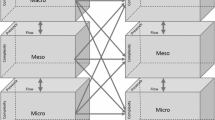Abstract
Having drawn together the qualitative results of understanding what Grace Leadership is, how it is developed, and applications in leadership contexts, it is appropriate to consider necessary future research. This should include broader analysis of Grace Leadership outside a Christian perspective, identifying Grace Leaders, and understanding how to apply it.
Access provided by Autonomous University of Puebla. Download chapter PDF
Similar content being viewed by others
When we started this work, we had very little in the way of research on the role of grace in contemporary leadership. However, each of these chapters have made both a significant contribution to the understanding of Grace Leadership as well as an incentive to dig more deeply into this concept. There are at least three areas where future researchers can make further contributions to what has been started here.
First, future researchers should consider the concept of grace. This will require a deeper analysis of grace that draws on sources other than the Christian tradition. This will allow for a broader understanding of this unique leadership variable across other faith and humanistic understandings. It is hopeful that this work will be a starting point for this analysis. Throughout the work—and even the choice of index topics—words have been purposely chosen to begin the process of coding unique identifiers of grace.
Obviously, this will lean deeply, as is often the case, on qualitative research. Identifying primary sources across worldviews of the concept of grace, identifying common themes, and then meta-analyzing these results to further refine variables will assist in concentrating the search for Grace Leadership.
This will then contribute to an operationalized definition of grace with specific variables. Such a construct will allow for researchers to pursue quantitative analysis that seeks to further refine the actual variables that allow leadership scholars to identify Grace Leaders.
Such an identification segues nicely to the second area of study: identifying Grace Leaders. While it is tempting to focus solely on contemporary examples, researchers should not forget the significant body of leadership material that is provided to us from historical figures. It is hopeful that this work has not only begun that research, but also has demonstrated that historical material, even in the form of sacred texts, can provide valuable results. Both contemporary and historical figures also have the added benefit of being drawn from unique contexts including demographical, socio-cultural, temporal, and philosophical backgrounds. Each of these distinct perspectives allow researchers to see grace from diverse standpoints, much like different people looking at different sides of a Rubics Cube. This inclusion of multiple perspectives is to the benefit of the research, especially in an area of study with such paucity of material.
However, as has been noted, simply identifying Grace Leadership variables and exemplars is not enough. We must, thirdly, apply Grace Leadership. Theory is helpful for the bell curve, but every leader is going to experience the outliers. It is in those seemingly destitute and barren places of leadership that application of Grace Leadership will not only be most helpful, but, perhaps, most needed. It is the hope of each of the contributors of this work that not only will we come to a deeper understanding of what Grace Leadership is, who can exemplify this leadership to future generations, but that practical applications of Grace Leadership, even in the most difficult of contexts, will be developed.
Author information
Authors and Affiliations
Corresponding author
Editor information
Editors and Affiliations
Rights and permissions
Copyright information
© 2022 The Author(s), under exclusive license to Springer Nature Switzerland AG
About this chapter
Cite this chapter
Huizing, R.L. (2022). Epilogue: What Shall We Do Now?. In: Huizing, R.L. (eds) Grace Leadership. Christian Faith Perspectives in Leadership and Business. Palgrave Macmillan, Cham. https://doi.org/10.1007/978-3-031-04488-5_13
Download citation
DOI: https://doi.org/10.1007/978-3-031-04488-5_13
Published:
Publisher Name: Palgrave Macmillan, Cham
Print ISBN: 978-3-031-04487-8
Online ISBN: 978-3-031-04488-5
eBook Packages: Business and ManagementBusiness and Management (R0)




